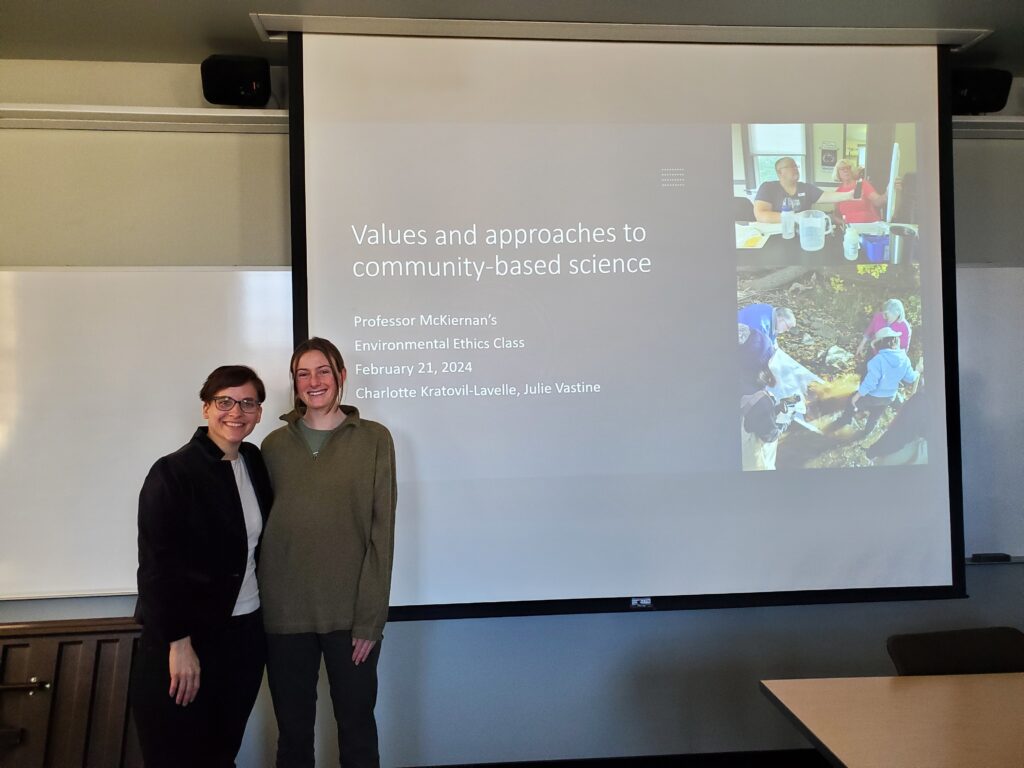“The environmental justice movement has changed the way scientists, researchers, policy makers, and educators go about their daily work. This bottom-up movement has redefined environment to include where people live, work, play, go to school, as well as how these things interact with the physical and natural world.”
In 2001, Robert Bullard published these words in his essay, Environmental Justice in the 21st Century: Race Still Matters. Students in Professor Amy McKiernan’s Practical Ethics course read this work as a part of their unit on environmental ethics. In his essay, Bullard articulates the key role communities across the country have had in “[organizing] their own networks and [forcing] their inclusion into the mainstream of public decision making.” Building off of these ideas, Alliance for Aquatic Resource Monitoring (ALLARM) Director Jules Vastine and I visited Professor McKiernan’s class to discuss the field of community science, how it can be used as a tool for equity, and how we incorporate these principles into our work.
Jules kicked off the presentation by introducing the field of community science. They emphasized the power of volunteers and discussed what values are important in collaborations, opening the floor for students to share their thoughts. I next dove into how community science can be used as a tool to advance equity, defined in our talk as the fair treatment and distribution of resources in all communities with a particular emphasis on environmental and human health. I highlighted four key principles: sense of place and community, self-efficacy, critical consciousness, and the “by the people, for the people” model. Using these concepts, I described how our relationships with our environments, our communities, and ourselves are key factors driving volunteer motivations and achieving positive outcomes.
Following a chance for students to reflect on their perceptions of the field, Jules discussed the diverse forms of volunteer monitoring occurring across the United States and the spectrum in which collected data are used. They then introduced ALLARM and highlighted our organizational values. These values include cultivating a diverse, inclusive, and equitable environment, fostering collaboration and meaningful relationships, and adapting programs to incorporate outside feedback and criticism.
I concluded the presentation by reflecting on my experience with ALLARM. When I was a first-year student at Dickinson, I remember reading Bullard’s words for the first time as a student in Professor McKiernan’s Practical Ethics course. I also remember learning about ALLARM for the first time that semester, discussing the organization with Professor McKiernan and asking for her assistance in my application. Jules was happy with the class visit, expressing that they “love opportunities for watershed coordinators to apply what they have learned at ALLARM and bring it back into the classroom space.” In our discussion after the class, Jules reflected that “to see you teach others by building off your own experience in a class that you once sat in was a great full circle experience.” I agreed, grateful to have taken a class with the wonderful Professor McKiernan and to have had the opportunity to come back as a senior and share some of the things I have learned since.
In the three years since I sat as a student in Professor McKiernan’s class, I have come to understand and appreciate the importance of community science and the volunteers who dedicate their time and energy to ensuring its success. I recognize that ALLARM is more than simply a water quality monitoring organization; we are a part of a larger movement to foster connections with our environments and communities in pursuit of equity and meaningful social change.
